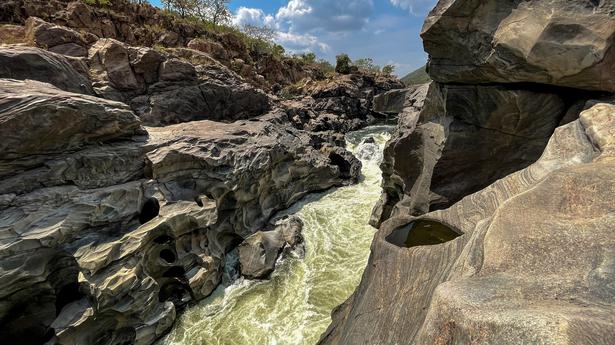
Why the Mekedatu water project continues to divide Karnataka and Tamil Nadu
The Hindu
On May 30, the Karnataka Cabinet approved the resolution of the State Legislative Assembly and Legislative Council that urged the Centre to provide clearance to the Mekedatu water project. This is the latest attempt by a state that has been knocking on the doors of various institutions to make the dam project a reality
About 100 km away from the hustle and bustle of Bengaluru, the Cauvery sashays down the picturesque rocky terrain of Mekedatu. Broadly translated as “goat’s lap” in Kannada, Mekedatu is part of the Cauvery Wildlife Sanctuary, and is barely 3 km downstream the confluence of the Arkavathy and Cauvery rivers called Sangama.
The popular tourist spot has been at the centre of intense discussion between Karnataka and Tamil Nadu, the two States through which the Cauvery mostly flows. Of late, the former has been pursuing, with renewed interest, the project of building a reservoir to cater to the drinking water requirements of Bengaluru, allocating ₹1,000 crore for it in this year’s budget.
The Karnataka Cabinet on May 30 approved the resolution of the Karnataka Legislative Assembly and Legislative Council that urged the Centre to provide clearance to the Mekedatu project.
The Cabinet was also said to have approved the resolution passed by both the Houses that the DPR for Godavari-Krishna-Pennar-Cauvery-Vaiagai-Gundar project taken up by Tamil Nadu should not be cleared till the decision on the distribution of the rightful share of all the basin states were established.
“I have not shifted from my place — Yelahanka — because my area is covered under the Cauvery water supply scheme, even though it is not part of what is called the core city,” says B. Kumar, a middle-aged senior IT professional. Invariably, all residents of the metropolis, including those in added or extended areas, want the Cauvery water, because the quality of groundwater is not that good. This creates the need for a project such as Mekedatu, he feels.
As the city continues to expand and and draw more and more IT companies, the demand for clean water does not seem to end.
The Bangalore Water Supply and Sewerage Board supplies 1,450 million litres a day (MLD), using the Cauvery as the source, as per the information available on its website. Another project, envisaging the supply of 775 MLD, is under way. But, it looks like even this project may not quench the thirst of burgeoning Bengaluru. As per an estimate, the population of Bengaluru, which is now 13 million, is expected to touch the 20-million mark by 2031, when the city will need 4,000 MLD.

 Run 3 Space | Play Space Running Game
Run 3 Space | Play Space Running Game Traffic Jam 3D | Online Racing Game
Traffic Jam 3D | Online Racing Game Duck Hunt | Play Old Classic Game
Duck Hunt | Play Old Classic Game











